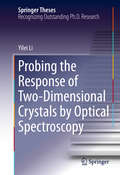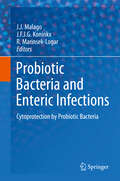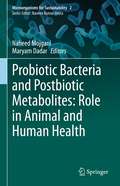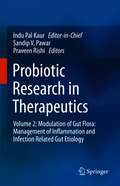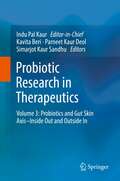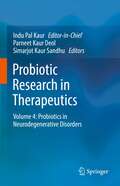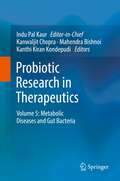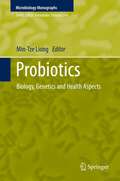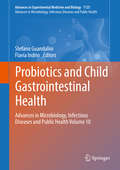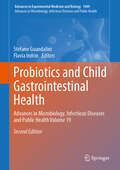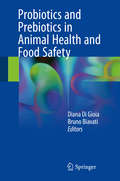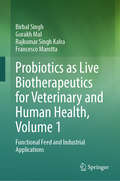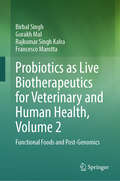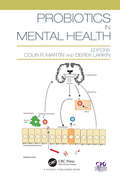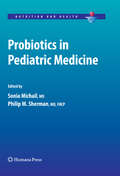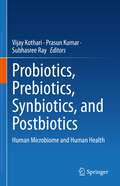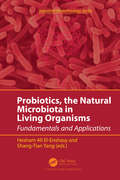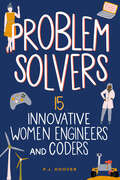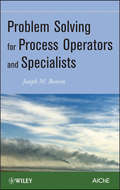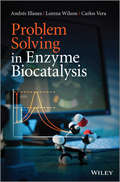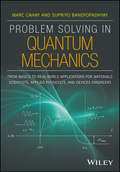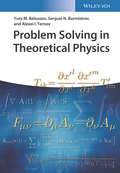- Table View
- List View
Probing the Response of Two-Dimensional Crystals by Optical Spectroscopy
by Yilei LiThis thesis focuses on the study of the optical response of new atomically thin two-dimensional crystals, principally the family of transition metal dichalcogenides like MoS2. One central theme of the thesis is the precise treatment of the linear and second-order nonlinear optical susceptibilities of atomically thin transition metal dichalcogenides. In addition to their significant scientific interest as fundamental material responses, these studies provide essential knowledge and convenient characterization tools for the application of these 2D materials in opto-electronic devices. Another important theme of the thesis is the valley physics of atomically thin transition metal dichalcogenides. It is shown that the degeneracy in the valley degree of freedom can be lifted and a valley polarization can be created using a magnetic field, which breaks time reversal symmetry in these materials. These findings enhance our basic understanding of the valley electronic states and open up new opportunities for valleytronic applications using two-dimensional materials.
Probiotic Bacteria and Enteric Infections
by J.F.J.G. Koninkx R. Marinsek-Logar J. J. MalagoEvery day many people suffer from intestinal diseases. These disorders can result from pathogens like bacteria, fungi, parasites and viruses, but the causes of non-infectious intestinal disorders and colorectal cancers remain to be elucidated. Disturbances to the normal gut flora (the microbiota) are central to the development of many, if not all, of these disorders. Disturbed gut microbiota is a prelude to public health issues like traveller's-, antibiotic- and Clostridium difficile-associated diarrhoea, irritable bowel syndrome, inflammatory bowel disease, and colorectal cancers. This book discusses the way intestinal disorders affect the microbiota, how the disturbed microbiotal balance leads to enteric disorders and the ways to prevent these disorders. Further his book explores the potential of probiotics (live microorganisms that when ingested bring a health benefit) in treating enteric disorders by analysing the probiotic genome through proteomics, metabolomics and functional assays. Discussed is how the ingestion of specific microorganisms repairs the disturbed microbiota and subsequently ameliorates enteric disorders. Finally this book addresses how genetic engineering and biotechnology will contribute to the development of effective and safe designer probiotics.
Probiotic Bacteria and Postbiotic Metabolites: Role in Animal and Human Health (Microorganisms for Sustainability #2)
by Naheed Mojgani Maryam DadarThis book covers all aspects of probiotic bacteria and their metabolites, as well as their role and significance in human and animal health. Given the role of probiotic bacterial strains in the production of short chain fatty acids, butyrate etc probiotics may be considered as an alternative approach for the prevention or treatment of intestinal dysbiosis, cancers, cardiovascular diseases, hypertensions. Additionally, the significance of probiotics added in aquaculture systems for improving health, performance and growth of aquatic organisms has been highlighted. In this book, the multi-functional role of probiotics and their post-biotic metabolites in improving overall health status of man and animals, is discussed. It is a comprehensive compilation useful for researchers, academics, veterinarians and students in the field of microbiology, food technology and biotechnology.
Probiotic Research in Therapeutics: Volume 2: Modulation of Gut Flora: Management of Inflammation and Infection Related Gut Etiology
by Indu Pal KaurIn a normal physiological state, several bacteria are present in the human gut that is essential to maintain the normal to healthy gastrointestinal function. Disturbances in this “normal flora” lead to gut inflammation and infection. This volume explores the potential of probiotics, the healthy bacteria, to manage gut-related diseases including gastrointestinal cancers, ulcerative colitis, H. pylori infections, and diarrhea; vaginosis; oral health; airway inflammation; and atopic dermatitis. The concept of designer probiotics, edible vaccines and future scope of research in the field is also presented. The animal models used for studying the benefits of probiotics in gut inflammation are described for beginners.
Probiotic Research in Therapeutics: Volume 3: Probiotics and Gut Skin Axis–Inside Out and Outside In
by Indu Pal KaurRecent research in science establishes a direct relation between human gut and skin. Several species of live microbes inhabit the human skin and intestines which far outnumbers the mammalian cells in the human body. Research interest of Nextgen scientists is focused on beneficially harnessing this microbial population to address skin disorders like acne, rosacea, eczema, premature aging, and skin cancer which are established to be a result of skin-microbiome dysbiosis. This volume highlights evidence-based endeavours of the scientific community in this sector. Currently there is no concrete literature which gives a detailed vision on the relationship between gut microbiota and skin related disorders. This volume is an attempt to put together available data in the area and demonstrate usefulness of probiotics as a new therapeutic option for management of these skin diseases which currently show poor prognosis, high cost of treatment and compromised quality of life of the patient.
Probiotic Research in Therapeutics: Volume 4: Probiotics in Neurodegenerative Disorders
by Indu Pal KaurHumans have numerous microorganisms residing in the body, especially in the gut, far exceeding the human body's normal mammalian cells. Recent research links the gut microbiome, the population of microorganisms living in the gastrointestinal tract, with brain diseases. This volume explores the concept and possibility of its extension to manage a galaxy of CNS diseases, including Parkinson's, Alzheimer's, Autism spectrum disorders, depression, insomnia, and chronic fatigue syndrome. This volume elaborates about communication channels between gut and brain via the vagus nerve, short-chain fatty acids including omega acids, and other inflammasomes.In contrast to the available books on the topic, this title is more versatile and endeavors to bring together scientific pre-clinical, and clinical claims on the probable psychobiotic implication of probiotic therapy. The book will appeal similar to the general public, students, experienced researchers, and academicians. It is endeavored to address an aspect of probiotic usage beyond gut disorders. We hope that it would be helpful to people studying the human nervous system and related conditions with their treatments.
Probiotic Research in Therapeutics: Volume 5: Metabolic Diseases and Gut Bacteria
by Indu Pal KaurThis volume focuses on the potential use of probiotics in treating metabolic disorders such as diabetes mellitus, metabolic acidosis, and gut dysbiosis. Chapters draw an association between gut microbiota and its diversity with metabolic diseases like diabetes, obesity, related liver and gut disorders; gut-brain axis; increased inflammation, and a compromised immune system resulting from these manifestations and scope of intervention with probiotics. Special attention is laid on describing the mechanisms of action of such beneficial effects of probiotic administration. The ability of probiotics to decrease metabolic endotoxemia by restoring the disrupted intestinal mucosal barrier is also included.The volume is a comprehensive compilation describing the scope and application of probiotic and prebiotic therapy in treating metabolic disorders. Readers will discover how probiotics are not just confined to the microbiology industry but are showing promising results in the medical and pharmaceutical sectors.
Probiotics
by Min-Tze LiongProbiotic microorganisms have a long history of use, and their health benefits for hosts are well documented. This Microbiology Monographs volume provides an overview of the current knowledge and applications of probiotics. Reviews cover the biology and probiotic potential of the thoroughly studied prokaryotic genera Lactobacillus and Bifidobacterium, several eukaryotic microorganisms, probiotic strain characterization, and the analytical methods (such as FISH, microarray, and high throughput sequencing) required for their study. Further chapters describe the positive effects of probiotics on malabsorption disorders such as diarrhea and lactose intolerance, and document the clinical evidence of benefits in treating allergies and lung emphysema, and in dermatological applications. Also addresses are topics such as genetically engineered strains, new carriers for probiotics, protection techniques, challenges of health claims, safety aspects, and future market trends.
Probiotics and Child Gastrointestinal Health: Advances in Microbiology, Infectious Diseases and Public Health Volume 10 (Advances in Experimental Medicine and Biology #1125)
by Stefano Guandalini Flavia IndrioThis book shows the huge impact the gut microbiota has on the gastrointestinal health of humans with a particular focus on children. It also highlights the potential use of probiotic microorganisms to protect or improve children’s gastrointestinal health.Humans are not single organisms: We are a multi-organism structure composed of ourselves and our microbiota, living in close symbiosis since birth and even before. The huge impact that the billons of microscopic cells living in our gut have on our gastrointestinal and systemic health cannot be overestimated. The enormous progress that has been made in the past decade in our still very incomplete understanding of the gut microbiota is opening the door to potential applications in human health that were simply unthinkable before.One of the most interesting aspects of this new scientific horizon is the fact that we may identify (or even create in the laboratory) and utilize many of these “friendly bacteria” to protect, or improve our health. Thus, strains of probiotic microorganisms are being identified and studied in a vast array of clinical scenarios. Among the most investigated areas for probiotics is the gastrointestinal health of children.The topics addressed in this book are spanning from the development of the gut microbiota in the fetus and newborn all the way to current and potential applications in disparate conditions such as necrotizing enterocolitis, or infectious, or inflammatory conditions affecting the child. The book is written in a rigorous, evidence based manner by an international group of outstanding experts in these fields and is aimed at pediatric gastroenterologists, pediatricians and physician scientists alike.
Probiotics and Child Gastrointestinal Health: Advances in Microbiology, Infectious Diseases and Public Health Volume 19 (Advances in Experimental Medicine and Biology #1449)
by Stefano Guandalini Flavia IndrioThis fully updated second edition demonstrates the major impact that the gut microbiota has on human gastrointestinal health, with a special focus on children. The book also explores the potential use of probiotic microorganisms to protect or improve gastrointestinal health in children. Humans are not a single organism: We are a multi-organic structure composed of ourselves and our microbiota, living in close symbiosis since birth and even before. The enormous impact that the billions of microscopic cells in our gut have on our gastrointestinal and systemic health cannot be overstated. The tremendous progress that has been made in the last decade in our still very incomplete understanding of the gut microbiota opens the door to potential applications in human health that were simply unthinkable before. One of the most interesting aspects of this new scientific horizon is the fact that we can identify (or even create in the lab) many of these "friendly bacteria" and use themto protect or improve our health. Thus, strains of probiotic microorganisms are being identified and studied in a variety of clinical scenarios. One of the most studied areas for probiotics is pediatric gastrointestinal health. Topics covered in this book range from the development of the intestinal microbiota in the fetus and neonate to current and potential applications in various conditions such as necrotizing enterocolitis or infectious or inflammatory diseases of the child. Written by an international group of preeminent experts in these fields in a rigorous, evidence-based manner, the book is intended for pediatric gastroenterologists, pediatricians, and medical scientists alike.
Probiotics and Prebiotics in Animal Health and Food Safety
by Diana Di Gioia Bruno BiavatiThis book discusses the role of probiotics and prebiotics in maintaining the health status of a broad range of animal groups used for food production. It also highlights the use of beneficial microorganisms as protective agents in animal derived foods. The book provides essential information on the characterization and definition of probiotics on the basis of recently released guidelines and reflecting the latest trends in bacterial taxonomy. Last but not least, it discusses the concept of “dead” probiotics and their benefits to animal health in detail. The book will benefit all professors, students, researchers and practitioners in academia and industry whose work involves biotechnology, veterinary sciences or food production.
Probiotics as Live Biotherapeutics for Veterinary and Human Health, Volume 1: Functional Feed and Industrial Applications
by Birbal Singh Gorakh Mal Francesco Marotta Rajkumar Singh KalraThis Volume 1 of a two-volume work provides an up-to-date overview of the latest advances in live biotherapeutics research. It focuses on key areas within probiotics and microbiome studies from the veterinary sciences including their translation into commercial applications. The book is divided into three sections, comprising (I) fundamentals about probiotic resources, (II) probiotics for veterinary health, with chapters on farm animals, pets, wildlife and aquaculture, and (III) industrial applications of probiotics. The broad spectrum of industry-relevant contributions makes this work a valuable resource for industry professionals as well as researchers in functional feed and food biotechnology, applied veterinary microbiology and gastroenterology. Presenting novel and evidence-based research, this volume will drive the commercial enterprise and meets the great demand for good probiotic products in the veterinary medical sector.
Probiotics as Live Biotherapeutics for Veterinary and Human Health, Volume 2: Functional Foods and Post-Genomics
by Birbal Singh Gorakh Mal Francesco Marotta Rajkumar Singh KalraThis Volume 2 of a two-volume work provides an up-to-date overview of the latest advances in live biotherapeutics research, engineered and genome-edited probiotics. It focuses on key areas within probiotics and microbiome studies in human medicine, including their translation into commercial applications. The book is divided into three sections, comprising (I) biomedical and nutritional benefits of probiotics for human health, (II) post-genomic technologies in probiotics sciences and genome engineering, and (III) biosafety aspects and prospects of biotherapeutics. The broad spectrum of industry-relevant contributions makes this work a valuable resource for industry professionals as well as researchers in functional food and feed biotechnology, applied microbiology and gastroenterology. Presenting novel and evidence-based research, this volume will drive the commercial enterprise and meets the great demand for good probiotic products in the human medical sector.
Probiotics in Aquaculture
by Brian Austin S. M. SharifuzzamanThis book has been developed to provide a detailed discussion of probiotics, which have been evaluated for use predominantly in fish and shellfish aquaculture. This book highlights strengths and weaknesses in knowledge and discusses gaps that need to be addressed. There has been a great deal of research concerning the use of probiotics in aquaculture. To date, a wide range of Gram-positive and Gram-negative bacteria and some eukaryotes, i.e. yeasts and unicellular algae, has been reported to be beneficial to aquatic hosts. Following oral uptake, benefit includes improved growth performance and protection against many bacteria and some parasitic diseases. This book will be suitable for scientists, veterinarians, professionals, and senior students involved in aquaculture.
Probiotics in Mental Health
by Colin R. Martin Derek LarkinThe concept that the gut and brain are intricately linked is widely accepted not just within the lay community but increasingly within scientific and therapeutic circles as well. Terms such as "heartache" and "gut wrenching" are more than mere metaphor, they represent key fundamental aspects of human experience which all individuals will invariably endure from time to time. The relationship between the gut and brain is complex but fundamental to health and wellbeing. Increasing and compelling evidence supports the existence of a relationship between the health and status of the gut and the manifestation of significant psychopathology. Uniquely within the field of mental health and psychiatry, the role of gut flora and probiotics in both the understanding and treatment of mental illness represents an emerging science whether the potential for therapeutic intervention, through the use of probiotics, offers an opportunity to determine efficacy within a coherent evidence-based model of both action and pathology or, moreover, offers interventions that are comparatively benign compared to the side-effect profile associated with most drugs used to treat mental illness. <P><P>Probiotics in Mental Health examines the role of probiotics in a range of clinical presentations associated with significant psychopathology and facilitates a reconsideration of how mental illness may be conceptualised within a coherent gut-brain model of health and wellbeing. Under the rubric of enhancing wellbeing rather than dwelling on illness and disease, this exciting new volume not only comprises the latest evidence in the field but also advocates an approach characterised by the understanding of mental disorder within an evidence-based model and the pursuit of mental health and wellbeing through the most benign of interventions.
Probiotics in Pediatric Medicine
by Sonia Michail Philip M. ShermanProbiotics in Pediatric Medicine provides clinicians a tool to understand the current evidence for the role of probiotics in various pediatric disorders related to the gastrointestinal as well as the extra-intestinal tract. This book provides evidence-based up-to-date information from world experts in their fields to help clinicians make decisions regarding the use of probiotics. A list of resources, web sites, and references relevant to probiotics can be found in the appendix. Currently, the market for probiotics continues to rely heavily on health claims made by manufacturers and retailers. Clinicians have the sole responsibility to understand the various strains and preparations commercially available and to advise patients accordingly. Probiotics in Pediatric Medicine is an indispensable tool and a critical resource for health professionals that will aid in enhancing their ability to make the appropriate decisions regarding the use of probiotics.
Probiotics, Prebiotics, Synbiotics, and Postbiotics: Human Microbiome and Human Health
by Prasun Kumar Vijay Kothari Subhasree RayThis book explains the potential value of microbiome and microbiome composition associated with human health and diseases. The opening chapters describe the current state of knowledge regarding the human microbiome structure, function, and diversity. The mechanisms of action and the various putative uses of human microbiome are then examined specific to healthy and disease conditions. Readers will find detailed information on its manipulation of human microbiome studies as well as its applied and translational aspects in the current field. The latest knowledge on probiotics, prebiotics, synbiotics, and postbiotics is presented, and specific cases to date are discussed. This book features knowledge from leading researchers working on different aspects of the human microbiome and its manipulation for better health. Overall, this book is an excellent source for microbiome researchers and students from all levels seeking the most up-to-date advancements in the field and also to point toward the future directions.
Probiotics, the Natural Microbiota in Living Organisms: Fundamentals and Applications (Industrial Biotechnology)
by Shang-Tian Yang Hesham Ali El-EnshasyBeneficial microbes called probiotics exist naturally in our bodies and play a vital role in our health. Probiotics have been known to produce important microbiota of antimicrobial compounds that enhance our immunity to counter the harmful effects of pathogenic organisms. These microbes are also used in the treatment of diseases and in negating the side effects of chemically synthesized medicines. The study of probiotic organisms and their wide applications in industrial products for human and animal uses has thus gained momentum. This book provides a comprehensive review on the research and applications of probiotics. It serves as a reference and resource for undergraduate and postgraduate students, researchers, companies, and policy makers who are active in fields related to functional food and feed, industrial biotechnology, nutraceuticals, and medicine. All chapters in this book have been written and edited by leading experts in the respective fields from academia, industry, or government.
Problem Solvers: 15 Innovative Women Engineers and Coders (Women of Power #7)
by P. J. HooverWhen engineers are faced with an impossible problem, they don't quit. They look for solutions. These 15 women are coders and engineers who have faced impossible problems and found solutions. They are each doing amazing work in technical fields while facing unique challenges that are not equally faced by men. Some have faced work/life balance offsets and long-distance relationship challenges. Others have faced teen pregnancy, homelessness, and domestic abuse. Many may have not had the same technical encouragement growing up that their male colleagues had. Science has typically been considered a man's field of study. There are all sorts of reasons why this is the case, though none of them is valid in today's society. Women can and should be anything they want to be. Problem solving with science and math is everyone's field, and it's time for the world to see powerful women succeeding in it.
Problem Solving Approaches for Maintaining Operational Excellence in Process Plants
by Joseph M. Bonem Nattapong Pongboot Wiroon TanthapanichakoonComprehensive reference providing methods for process engineers and operators to solve challenging process problems and develop working hypotheses for typical process equipment Problem Solving Approaches for Maintaining Operational Excellence in Process Plants provides a template for achieving an enhanced level of operating efficiency in chemical processing plants and refineries. With examples included throughout to demonstrate key concepts, this book includes methods for formulating working hypotheses for typical process equipment such as pumps, compressors, heat exchangers/furnaces, fractionating towers, and reactors, with additional information on defining and setting metrics and the application of the techniques in unusual situations, as well as the application of these techniques in view of commercially available computer simulation programs. This book covers topics including initial considerations in problem solving, basic steps in problem solving, and verification of process instrument data, with solved problems showing how techniques can be applied to prime movers, plate processes, kinetically limited processes, and unsteady state problems. This newly revised and updated Second Edition includes coverage of the latest research and developments in the field. Written by a team of highly qualified industry professionals, Problem Solving Approaches for Maintaining Operational Excellence in Process Plants includes discussion on: Lumped parameters as the ideal approach to determine values for key performance indicators (KPIs)Theoretical KPIs in comparison to actual operation as a method to find “hidden problems”Situations where experience-based solutions are unavailable due to lack of technically trained personnelSolutions to problems where a previous analysis has confirmed a need for new equipment or enhanced operating proceduresDigital twins and their usefulness in predicting yields, executing plant operations, and training operating and technical personnel Problem Solving Approaches for Maintaining Operational Excellence in Process Plants is an essential reference on the subject for chemical engineers, industrial engineers, process operators, process shift supervisors, chemical engineers with minimal exposure to industrial calculations, and industrial managers who are looking for techniques to improve organization problem solving skills.
Problem Solving for Process Operators and Specialists
by J. M. BonemThis book provides methods to train process operators to solve challenging problems. The book is split into two parts. The first part consists of two parts; first developing a daily monitoring system and second providing a structured 5 step problem solving approach that combines cause and effect problem solving thinking with the formulation of theoretically correct hypotheses. The 5 step approach emphasizes the classical problem solving approach (defining the sequence of events) with the addition of the steps of formulating a theoretically correct working hypothesis, providing a means to test the hypothesis, and providing a foolproof means to eliminate the problem. The initial part of the book focuses on defining the problem that must be solved and obtaining the location, time and quantity based specifications of the problem. This part of the book also presents techniques to find and define problems at an early point before they progress to the critical level.The second part of the book deals with the utilization of fundamental chemical engineering skills to develop a technically correct working hypothesis that is the key to successful problem solving. The primary emphasis is on simple pragmatic calculation techniques that are theoretically correct. It is believed that any operator can perform these calculations if he is provided the correct prototype. Throughout the book, the theory behind each pragmatic calculation technique is explained in understandable terms prior to presenting the author's approach. These techniques have been developed by the author in 50+ years of industrial experience. The book includes many sample problems and examples of real world problem solving. Using these techniques, theoretically correct working hypotheses can be developed in an expedient fashion.
Problem Solving in Chemical Reactor Design
by Juan A. ConesaExtensive workbook with more than 200 up-to-date solved problems on advanced chemical reactors for deeper understanding of chemical reactor design Problem Solving in Chemical Reactor Design provides in-depth coverage of more than 200 solved complex reactor design problems extracted from core chemical engineering subject areas. The problems in this book cover the design of non-ideal, catalytic, multiphase, heterogeneous, and biochemical reactors rather than focusing on basic Chemical Reactor Engineering concepts. Each complex problem is solved using simple procedures and mathematical tools, enabling readers to better understand the correct procedure for solving problems and solve them faster, more conveniently, and more accurately. This book is inspired by more than two decades of the author's teaching experience in chemical reactor engineering. Accompanying electronic materials include spreadsheets and easily understandable Matlab® programs, which can both be downloaded from the Wiley website. Some of the topics covered in Problem Solving in Chemical Reactor Design include: Optimization, operation, and complexities of reactor design in the face of non-idealities such as mixing issues and residence time distributions Utilization of the tanks-in-series model, dispersion model, and intricate combinations of ideal reactors to elucidate the impact on conversion rates Signal processing within the domain of chemical reactor engineering, specifically focusing on convolution and deconvolution methodologies Reaction kinetics, diffusion dynamics, and catalyst efficiency in catalytic reactor design, and design of gas-catalytic and gas-liquid-solid catalyst systems in multiphase reactors Problem Solving in Chemical Reactor Design is an excellent learning resource for students and professionals in the fields of chemical engineering, pharmaceuticals, biotechnology, and fine chemistry.
Problem Solving in Enzyme Biocatalysis
by Carlos Vera Lorena Wilson Andrés IllanesEnzyme biocatalysis is a fast-growing area in process biotechnology that has expanded from the traditional fields of foods, detergents, and leather applications to more sophisticated uses in the pharmaceutical and fine-chemicals sectors and environmental management. Conventional applications of industrial enzymes are expected to grow, with major opportunities in the detergent and animal feed sectors, and new uses in biofuel production and human and animal therapy.In order to design more efficient enzyme reactors and evaluate performance properly, sound mathematical expressions must be developed which consider enzyme kinetics, material balances, and eventual mass transfer limitations. With a focus on problem solving, each chapter provides abridged coverage of the subject, followed by a number of solved problems illustrating resolution procedures and the main concepts underlying them, plus supplementary questions and answers.Based on more than 50 years of teaching experience, Problem Solving in Enzyme Biocatalysis is a unique reference for students of chemical and biochemical engineering, as well as biochemists and chemists dealing with bioprocesses.Contains: Enzyme properties and applications; enzyme kinetics; enzyme reactor design and operation 146 worked problems and solutions in enzyme biocatalysis.
Problem Solving in Quantum Mechanics: From Basics to Real-World Applications for Materials Scientists, Applied Physicists, and Devices Engineers
by Supriyo Bandyopadhyay Marc CahayThis topical and timely textbook is a collection of problems for students, researchers, and practitioners interested in state-of-the-art material and device applications in quantum mechanics. Most problem are relevant either to a new device or a device concept or to current research topics which could spawn new technology. It deals with the practical aspects of the field, presenting a broad range of essential topics currently at the leading edge of technological innovation. Includes discussion on: Properties of Schroedinger Equation Operators Bound States in Nanostructures Current and Energy Flux Densities in Nanostructures Density of States Transfer and Scattering Matrix Formalisms for Modelling Diffusive Quantum Transport Perturbation Theory, Variational Approach and their Applications to Device Problems Electrons in a Magnetic or Electromagnetic Field and Associated Phenomena Time-dependent Perturbation Theory and its Applications Optical Properties of Nanostructures Problems in Quantum Mechanics: For Material Scientists, Applied Physicists and Device Engineers is an ideal companion to engineering, condensed matter physics or materials science curricula. It appeals to future and present engineers, physicists, and materials scientists, as well as professionals in these fields needing more in-depth understanding of nanotechnology and nanoscience.
Problem Solving in Theoretical Physics
by Yury M. Belousov Serguei N. Burmistrov Alexei I. Ternov"Problem Solving in Theoretical Physics" helps students mastering their theoretical physics courses by posing advanced problems and providing their solutions - along with discussions of their physical significance and possibilities for generalization and transfer to other fields.
